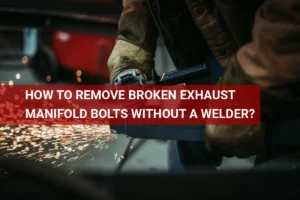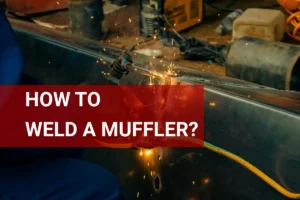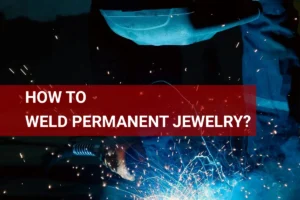How to Weld a Rose? Tips, Steps & FAQs on Metal Roses
Published on: March 21, 2025 | Last modified: March 4, 2025
By: Tyler James
A rose is a beautiful flower known for its striking colors and sweet fragrance. In welding, a rose often refers to intricate metal art shaped like this flower.
I regularly hear the question, how to weld a rose? It’s crucial to follow the right steps when crafting this piece; I’ve learned that preparation makes a big difference. A well-planned project leads to better results, saving you time and materials along the way.
In this guide, you’ll learn about the essentials of creating a welded rose, different types of roses in welding, steps for welding a rose, and factors affecting how to weld a rose. Plus, I’ll share insights from my own experience using various techniques for how to make a welded rose. Let’s get started on this exciting project!
Contents
How to Weld A Rose?
A rose is a beautiful metal sculpture. To weld a rose, use 0.030 inches (0.76 Mm) welding wire and 75-25 argon/CO2 gas. It’s tricky, yet rewarding. Welded roses are often used in gardens and gifts.
What is a Rose?
A rose is a flowering plant in the genus Rosa. There are over 300 species of roses, ranging in size from small shrubs to large climbing varieties. Some roses can grow up to 2 meters (6 Feet) tall and thrive in temperate regions worldwide. You’ll find roses in various colors, including red, pink, yellow, and white, creating stunning displays in gardens and parks.
Welding a rose is a creative process that captures many artists’ attention. In my experience, welding roses brings metal sculptures to life. You can use techniques like MIG welding or TIG welding to shape and refine intricate details.
I’ve used these techniques for custom metal art projects. Creating welded roses not only adds a unique decorative element but also showcases skill with tools like plasma cutters and welders. When I work on these, I often consider how to weld a rose from washers; it’s a practical way to repurpose materials while crafting something special.
Types Of Roses in Welding
What types of roses can you create through welding?
-
Metal Roses
Metal roses are made from various metal sheets and rods. To create a sturdy metal rose, cut the metal into petal shapes. Use a MIG welder for seamless joints, focusing on the edges where the petals connect.
-
Wrought Iron Roses
Wrought iron roses are durable with a classic look. To forge one, heat the iron until it’s malleable. Hammer the petals into shape, then use a TIG welder to fuse the parts securely.
-
Steel Roses
Steel roses are strong and wear-resistant. To make one, start by cutting rough petal shapes with a plasma cutter. TIG weld the petals together and finish with a grinder for a smooth surface.
-
Bronze Roses
Bronze roses have a unique color and finish. To create a bronze rose, use bronze rod and a MIG welder. Keep the heat low to avoid warping, and layer the petals carefully for a natural appearance.
-
Stainless Steel Roses
Stainless steel roses resist corrosion and shine beautifully. To weld a stainless steel rose, use the correct filler material. A TIG welder is best for a clean weld, ensuring precision around the petals. Ensuring safety during welding is crucial as improper practices can lead to accidental electric shock, so it’s important to understand what causes most electric shock in such environments.
So far we covered the different varieties of roses in welding. Next, let’s look at the process for welding a rose.
Steps for Welding a Rose
Now, we’ll cover how to create a beautiful welded rose using metal. Follow these steps carefully for the best results!
-
Shape the Petals
Start by cutting six petal shapes from 4 mm (1/8 Inch) thick sheet metal. You can use a plasma cutter or an angle grinder for precision. Each petal should be about 10 cm (4 Inches) long and 6 cm (2.5 Inches) wide. Don’t worry if your first cuts aren’t perfect; adjusting shapes on the fly adds to the fun.
After cutting, gently bend the edges of each petal for depth and contour. Use a hammer to create specific curves. This adds character and realism to your flower. Rounding the tips mimics natural petals better than sharp edges!
-
Prepare the Base
Next, choose a solid base for your rose, about 6 cm (2.5 Inches) wide. A round disc works well. Ensure it’s stable enough to hold the weight of the petals. I often use a scrap piece of metal to experiment with placement before making it permanent.
Once decided, secure the base to your work table with clamps. This keeps it stable while you weld the petals onto the base. With stability, you can focus on your masterpiece instead of worrying about slipping parts!
-
Weld the Petals
Place the first petal on the base and start welding with a MIG welder set at about 20-25 volts. A travel speed of 3-4 cm per second works best for a clean joint. Prioritize even welds as a guide for the others. Maintain an angle of about 45 degrees for maximum penetration. Understanding the different welding positions like 1F, 2F, 3F, and 4F can enhance the technique used in MIG welding.
.
I recommend staggering each petal’s placement for a layered look. Position the next petal next to the first, maintaining a consistent distance. Adjust each one slightly to overlap, creating natural variations. This step can be tedious but makes a striking difference!
-
Create the Stem
After completing the petals, it’s time for the stem. Use a solid rod or tube about 1.5 cm (0.6 Inches) in diameter and around 50 cm (20 Inches) long to add sturdiness. Ensure the stem connects seamlessly with the base; welding it securely is vital for overall strength.
Weld the bottom of the rod to the base to support the weight of the petals. Make sure your welding settings are suitable for thicker materials; around 24-26 volts should work. A solid joint here is crucial; a flawed stem can ruin your entire design.
-
Add Finishing Touches
Finally, inspect your welds and grind any rough spots for a smooth finish. This helps your rose stand out beautifully. I like using a flap disc on a grinder for the best results—smooth without removing too much material!
Consider painting or applying a clear coat to protect your creation. If you choose paint, use high-temp spray paint to withstand welding heat. It adds a little flair! Just be patient, and the results will be worth it. Properly adjusting your welding helmet is crucial for improving welding efficiency and safety, and you can find detailed guidance in this guide to adjusting welding helmets.
So far we covered the process of creating a welded rose. Next, let’s look at the elements influencing rose welding techniques.

Factors Affecting How to Weld a Rose
What factors influence your success in creating a welded floral masterpiece?
-
Material Type
The type of metal you choose significantly impacts your project. Common options are mild steel and stainless steel, with mild steel being easier to weld at approximately 500 °C (932 °F).
-
Welding Method
Different welding methods, like MIG (Metal Inert Gas) or TIG (Tungsten Inert Gas), affect the finish and strength. For fine, detailed work like a rose, TIG usually provides the best control for intricate detailing. Selecting the right process becomes crucial when working with specific materials such as zinc-plated steel, where understanding the challenges involved can greatly impact the outcome. Discover more about welding zinc-plated steel.
-
Heat Settings
Pay close attention to heat settings. A typical range for welding thin metal flowers is 200-300 amps. Too much heat can warp your rose, while too little might not secure the pieces properly.
-
Environmental Conditions
Welding in damp areas can result in poor quality welds. Aim for dry, well-ventilated spaces. Ambient temperatures below 10 °C (50 °F) can also compromise your weld’s integrity.
-
Weld Design
Your weld design is crucial. For a rose, consider using a rosette weld at the center for added strength. Experimenting with different designs can lead to more stunning results.
So far we covered the elements influencing rose welding. Next, let’s look at advanced methods for creating welded roses.
Advanced Techniques for Welding a Rose
Want to take your metal rose to the next level? Here are some advanced techniques to enhance your artistry.
Layering Technique
Layering adds depth to your welded rose. Instead of welding petals flat, overlap them at varying angles. This gives your flower a more natural look.
Texturing the Metal
Texture can elevate your project. Use a hammer or metal files to create patterns on the petals, mimicking the natural surface of flower petals. It adds uniqueness to each piece.
Using Patinas for Color
Add some color with patinas! By applying chemical solutions, you can achieve vibrant colors on your metal. Make sure to follow the manufacturer’s instructions for safe application.
So far we covered advanced methods for crafting a rose with welding. Next, let’s look at precise tooling techniques.

Tool Techniques for Precision
Precision tools can significantly improve your results. Here are some tools and their uses:
| Tool | Use | Material Compatibility |
|---|---|---|
| Plasma Cutter | For detailed cuts and shapes | Mild steel, stainless steel |
| Angle Grinder | For smoothing and shaping edges | All metals |
| TIG Welder | For precise welding | Aluminum, stainless steel |
| MIG Welder | For faster welding | Mild steel, aluminum |
Using these tools effectively will enhance the quality of your welded rose. Experiment with different techniques, and don’t forget to enjoy the process!
Frequently Asked Questions (FAQs)
Now let us look at some common questions I typically get asked.
What Do I Need to Weld a Flower?
To weld a flower, you’ll need a welding machine, safety gear, and metal pieces. A MIG welder, for example, will cost around $200 to $500, depending on the brand. Don’t forget gloves and a helmet to protect yourself!
What Do You Need to Make a Metal Rose?
To make a metal rose, you need steel or metal sheets, a welding machine, and tools like a grinder and pliers. Having metal that’s at least 1.5 mm (0.06 In) thick is ideal for sturdiness while allowing for shape creation.
What is the Thinnest Metal You Can MIG Weld?
The thinnest metal you can MIG weld is around 0.6 mm (0.024 In) thick. Under this thickness, you risk burning through the metal. Maintaining the correct settings is key for thinner materials.
What Do You Spray on Metal Before Welding?
You should spray a weld release agent or a cleaner on the metal before welding. It helps prevent contamination and creates a cleaner weld. This preparation enhances your overall weld quality and reduces defects. Being aware of the potential health risks associated with welding is crucial, as certain processes may increase cancer risk.
What is a Rosebud in Welding?
A rosebud in welding refers to a broad, flame-shaped nozzle that produces a large, soft flame. It’s ideal for heating metal uniformly and can reach temperatures around 1,200°C (2,192°F). Use it for tasks such as bending or preheating metal.
What is a Rosette Weld?
A rosette weld is a circular weld joint typically used to fasten two pieces of metal at an angle. It provides significant strength and is often ideal for joining pipes or structural frames. This type is efficient and can withstand high stress levels.
Conclusion
We’ve made it to the end, and I hope it was helpful. We covered how to weld a rose, what a rose is, and the various types of roses in welding. We also discussed the steps for welding a rose, factors affecting the process, and answered frequently asked questions.
I trust these insights have been helpful as you explore how to weld a rose. To put it simply, you’ll start by gathering materials like metal pieces, a welding torch, and safety gear, then follow the steps to create the unique shape of a rose. Remember, you can use different metals and techniques, whether you’re making a rose out of washers or without welding at all, to create a stunning piece.
If you’re eager to deepen your understanding and skills in welding, be sure to check out What is Welding for a comprehensive look at everything welding-related.
References
- Jeffus, L. (2020). Welding: Principles and Applications (9th ed.). Boston, MA: Cengage Learning.
Tyler is a passionate DIY welder and self-taught metal artist with years of hands-on experience transforming raw materials into functional and artistic creations. Specializing in MIG welding, Tyler crafts everything from custom furniture to outdoor sculptures, blending creativity with technical skill. Committed to making welding accessible, Tyler shares practical insights and project inspiration to help beginners and hobbyists confidently explore the world of metalworking.
Art, Metal Art, Metal Sculpture, MIG Welding, TIG Welding, Welded Rose, Welding, Welding Techniques, Welding Wire







